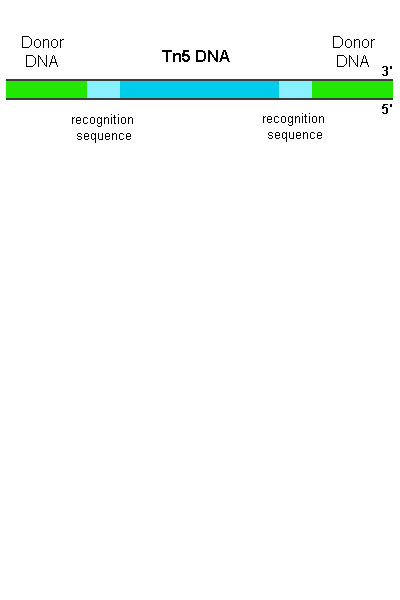| UHH > Faculty of Biology > Teaching Stuff > Highlights of Biochemistry > Transposition | search |
Transposition is another means of generating genetic diversity. Transposons are mobile genetic elements carrying some payload and coding the enzyme needed for their excision and reinsertion from/to the genome of the host. The procedure is universal, transposons are found from bacteria to man. According to their mechanisms transposons are sorted into families. Here the action of transposon Tn5 will be described, along with the structure of the enzyme involved.
 The mechanism of Tn5 transposition may be dissected into several steps:
The mechanism of Tn5 transposition may be dissected into several steps:
| 1 | The enzyme transposase binds to the recognition sequence of the transposon |
| 2 | The two transposase molecules align and thereby form a synaptic complex |
| 3 | A water molecule activated by the enzyme hydrolyzes one DNA strand at the Tn5-host junction |
| 4 | The 3'-hydroxyl generated in step 3 is activated by the enzyme to attack the other DNA strand |
| 5 | A hairpin loop on the side of the transposon is formed and the donor DNA set free |
| 6 | The hairpin loop is opened by another activated water molecule |
| 7 | Both ends of the transposon are held in the transposase complex. This state is shown in the following Chime script. |
| 8 | The complex looks out for a target DNA strand |
| 9 | The complex binds to the target DNA |
| 10 | The 3' hydroxyl groups of Tn5 are activated to attack the target DNA strands |
| 11 | The transposon is inserted in the target DNA |
The transposase coded by Tn5 was crystallized in the presence of duplex DNA corresponding to the Tn5 recognition sequence.
Literature:
A Bhasin et al, Hairpin formation in Tn5 transposition, J. Biol. Chem. 274 (1999) 37021-37029
PA Rice & TA Baker, Comparative architecture of transposase and integrase complexes, Nature Struct. Biol. 8 (2001) 302-307